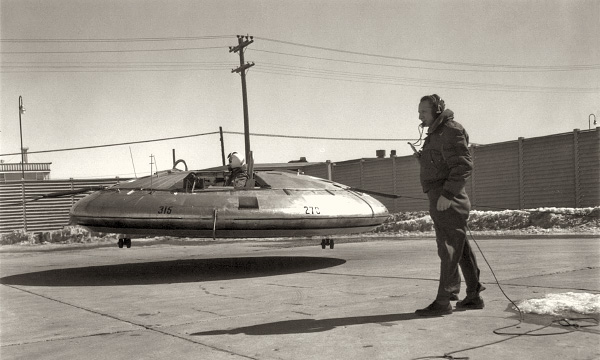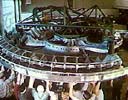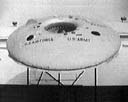|
|
AVROCAR VZ-9AV
(1952 - 1961)
|
|
|

|
|
|
|
|






 US Air Force general Donald Putt
US Air Force general Donald Putt
|
The National Aeronautics and Space Administration (NASA) had a wind tunnel at Moffett big enough to hold the VZ-9AV.
Ames Research Center at Moffett Field, California.
Both Avrocars ended up in the United States. The first remained at the NASA Ames facility after the project was cancelled. The second aircraft that flew the limited flight tests in Canada eventually arrived in Virginia at the U. S. Army's Ft. Eustis Trans-portation Museum east of Richmond, Virginia. In April 1966, the U. S. Air Force contacted the Smithsonian Air and Space Museum to say that the VZ-9AV at NASA Ames was available. In 1975, the National Air and Space Museum took possession of the first Avrocar, serial number 58-7055. The museum currently stores the aircraft at the Garber Restoration Facility at Silver Hill, Maryland.
Click here to view: the complete AVROCAR Patent!
|
Avrocar I Progress Report
01/02/1958 - 05/1959
|
|
Disc Flight Development, Avrocar I Progress Report
05/02/1959 - 04/12/1960 |
|
Avrocar Continuation Test Program and Terrain Test Program
06/01/1960 - 06/14/1961 |
|
The Avrocar was initially intended to be a vertical take-off and landing (VTOL) aircraft that could travel at speeds of up to Mach 4. During the Cold War, traditional airport runways were seen as easy targets for an attack. With a fleet of VTOL aircraft, the United States could build underground airports, protected from Soviet bombers. The Avrocar would ascend through a shaft and then zip away at supersonic speeds.
The Avrocar's disc shape and ability to hover bring to mind the flying saucers that we associate with extraterrestrial sources, but the project never really got off the ground–both figuratively and literally. From the start, the design was unstable and difficult to fly. Through extensive testing and modifications, Canada's Avro Aircraft Limited was able to improve stability, but the Avrocar was still only able to hover at a height of about three feet and travel at speeds not exceeding 35 mph.
In the Avrocar progress report films, you can see the development and improvement of the vehicle during the period between February 1958 and June 1961. The first film illustrates the construction of a wooden mock-up of the disc, prior to construction of the prototypes. The second film addresses modifications to the initial design to help improve stability and the pilot's control of the vehicle. The final film follows the Avrocar as it is unleashed on a test course containing real-world conditions the aircraft is expected to successfully navigate. While the vehicle successfully crosses ditches and rough terrain, it turns out that all the dust and debris kicked up by the rotor was sucked right back into the disc's air intake, resulting in limited flight time.
Though the progress report films demonstrate improvements in the Avrocar's design and operation over a three year period, by the end of the final film it is apparent that meeting the project's original goals would require a huge investment in overhauling the design. At the end of 1961, the Pentagon cancelled the project.
|
Video and text Source:
The National Archives and Records Administration (NARA)
The National Archives and Records Administration (NARA) is home to a number of records from the Avrocar project. Some of these records were declassified in the fall of 2012, including schematic drawings and project reports. Other records, including the motion picture progress reports featured in this post, have been available to the public for much longer.
If you'd like to see the military's flying saucer, one of the Avrocar prototypes is on display at the National Museum of the US Air Force at Wright-Patterson Air Force Base in Dayton, Ohio.
|
Speacial thanks to Blake William B.
|
|
|

